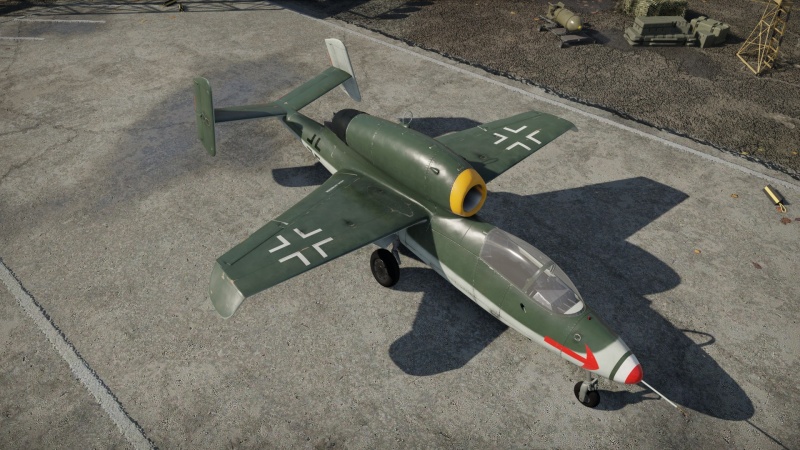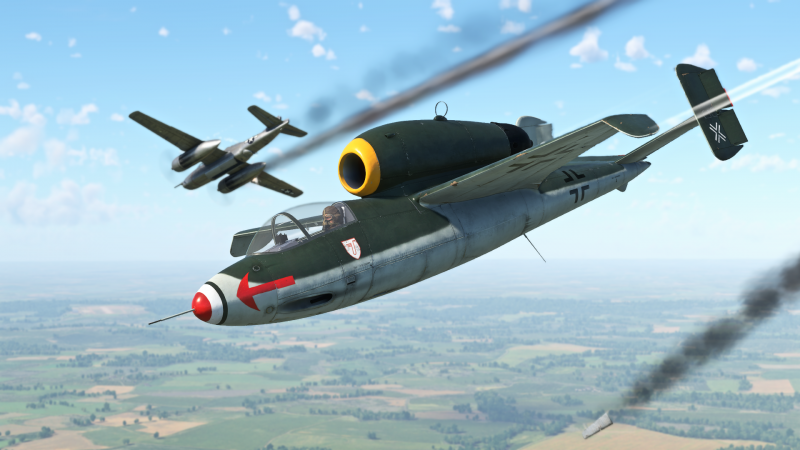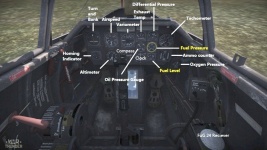He 162 A-2
| This page is about the German jet fighter He 162 A-2. For the other version, see He 162 A-1. |
Contents
Description
Initially designated the He 500, the He 162 was a very unique jet fighter. The He 162 was aptly nicknamed "Salamander" but was later given the official name "Volksjäger". It was intended to be flown by anyone, beginners and experts alike. One of the unique design features of the Salamander is the single jet engine mounted on the top of the fuselage. This provided easy access for maintenance and protected the engine from ingesting rocks or other debris on runways. The A-1 was armed with dual MK 108 cannons, but excessive vibrations when firing forced the A-2 variant to utilize the 20 mm MG 151 cannon found in many German aircraft. Although the Salamander had unfavourable landing and stall characteristics, it was quite a comfortable aircraft to fly, and pilots noted it was stable in flight.
The He 162 A-2 has been in the game since the start of the Open Beta Test prior to Update 1.27. It is one of the earliest jet fighters in-game and regularly faces propeller-driven aircraft. Like many jet fighters, the He 162 has an excellent top speed of 840 km/h (522 mph) and an even better structural speed limit of 1,040 km/h (646 mph). It can easily outrun and catch up to enemy propeller-driven fighters. However, the engine only outputs around 910 kgf of thrust, which means it takes a very long time to accelerate up to suitable speeds. Players should try not to dogfight enemy aircraft and instead make repeated passes on slower targets. Fortunately, the He 162 is quite manoeuvrable so it can compete with propeller-driven fighters in a pinch.
General info
Flight performance
| Characteristics | Max Speed (km/h at 6,000 m) |
Max altitude (metres) |
Turn time (seconds) |
Rate of climb (metres/second) |
Take-off run (metres) | |||
|---|---|---|---|---|---|---|---|---|
| AB | RB | AB | RB | AB | RB | |||
| Stock | 801 | 776 | 31.4 | 32.3 | 19.1 | 18.1 | 750 | |
| Upgraded | 875 | 840 | 28.8 | 30.0 | 28.2 | 23.4 | ||
Details
| Features | |||||
|---|---|---|---|---|---|
| Combat flaps | Take-off flaps | Landing flaps | Air brakes | Arrestor gear | Drogue chute |
| ✓ | ✓ | ✓ | X | X | X |
| Limits | ||||||
|---|---|---|---|---|---|---|
| Wings (km/h) | Gear (km/h) | Flaps (km/h) | Max Static G | |||
| Combat | Take-off | Landing | + | - | ||
| 677 | 648 | 500 | ~12 | ~7 | ||
| Optimal velocities (km/h) | |||
|---|---|---|---|
| Ailerons | Rudder | Elevators | Radiator |
| < 500 | < 500 | < 580 | N/A |
Engine performance
| Engine | Aircraft mass | |||||
|---|---|---|---|---|---|---|
| Engine name | Number | Basic mass | Wing loading (full fuel) | |||
| BMW 003 | 1 | 1,990 kg | 212 kg/m2 | |||
| Engine characteristics | Mass with fuel (no weapons load) | Max Takeoff Weight | ||||
| Weight (each) | Type | 8m fuel | 20m fuel | 26m fuel | ||
| 673 kg | Axial-flow turbojet | 2,132 kg | 2,342 kg | 2,465 kg | 2,495 kg | |
| Maximum engine thrust @ 0 m (RB/SB) | Thrust to weight ratio @ 0 m (108%) | |||||
| Condition | 100% | 108% | 8m fuel | 20m fuel | 26m fuel | MTOW |
| Stationary | 801 kgf | 910 kgf | 0.43 | 0.39 | 0.37 | 0.36 |
| Optimal | 801 kgf (0 km/h) |
910 kgf (0 km/h) |
0.43 | 0.39 | 0.37 | 0.36 |
Survivability and armour
- 15 mm steel - bulkhead behind cockpit
- Engine exposed on top of the fuselage
- Fuel tanks in fuselage and wings below the engine
Modifications and economy
"Offensive 20 mm", "Compressor", "Wings repair", then "Engine", is the recommended order of unlocking. The stock MG 151 belts are bad as they lack the very powerful HE Minengeschoß rounds. Compressor and Engine are no-brainers. Everything that improves acceleration is a must for early jets. Wings repair is superior to new cannons, the stock MG 151 does not overheat and accuracy is acceptable in short bursts.
Armaments
Offensive armament
The He 162 A-2 is armed with:
- 2 x 20 mm MG 151 cannons, chin-mounted (120 rpg = 240 total)
The twin MG 151s are one of the weaker cannons equipped by the early Rank 5 jets. However, when compared to the 30 mm MK 108s found on other German jets, its cannons have acceptable muzzle velocity, though this will remain a problem. The ammo count is less than enough considering the speeds at which jet combat takes place. As for ammunition belts, the air target belt is the best one due to its ample amount of HE rounds in the belt composition.
Usage in battles
This aircraft is best used exclusively for Boom & Zoom attacks and fighting at high altitudes (over 5 km).
It bleeds energy fast in dogfights against early jets, and when matched with propeller planes, dogfights become suicide. Head-ons may seem like a good idea due to the plane's small size and powerful 20 mm cannons, but keep in mind that most of the time you will be fighting American or British aircraft, which will often one-shot or severely damage you with their multiple sets of .50 cals or Hispanos.
He 162 is an excellent bomber hunter, especially if you choose to fly with minimum (8 min) fuel and go to intercept bombers attacking your team's bases. Your 20 mm and small size will make you a deadly opponent, but keep in mind that most propeller bombers at this rank have great defensive armaments. When up-tiered with jets you will probably never see a bomber in-game.
When attempting to Boom & Zoom enemy fighters, it is vital that you climb at least 1 km above the enemy. Try climbing along the corners of the map, as if you go head-on you'll run into fighters without the energy you need to get away. Avoid sharp turns when diving and pulling up as you lose energy very fast in this aircraft. This becomes even more important when up-tiered, as enemy jets at higher battle-ratings have no problem catching up to you just long enough to destroy you.
The best place for He 162 is combined battles, where it has relatively low SP requirements and does not face a large group of enemy fighters. In this mode fly with a minimum tank load (8 min) as it's all you need and it gives you agility. Just as in air realistic, use Boom & Zoom to shoot down enemies ground attacking your team or unsuspecting enemy fighters.
Pros and cons
Pros:
- One of the best climbing early jets
- Faces almost only propeller-powered aircraft and some early jets
- Great manoeuvrability at high speed
- Good acceleration for an early jet at speeds below 800 km/h
- Excellent shallow dive rate
- Hard-hitting armament of two 20 mm MG 151/20 cannons that fires Minengeschoß shells
- Small wing surface area means difficult target to shoot down
- Very good visibility
- Does not have war emergency power, however, the throttle can push up to 108%
- Relatively good bomber hunter, especially if the opponent lacks defensive armaments
- Can use its 108% throttle almost indefinitely above 6,000 m
- Great roll rate
Cons:
- Above 800 km/h, acceleration in straight line is almost non-existent
- Not beginner-friendly
- Suitable only for energy fighting, loses all energy in turns
- Bad manoeuvrability at low speed
- Very fragile even for a jet, a little damage can cause significant performance loss
- Limited amount of ammunition
- Limited energy retention due to bad high-speed engine performance and a lightweight airframe
- Setting throttle above 100% does not bring significant gain of power
- Armour protecting the pilot insufficient to prevent knock-out
- Difficulty with take-off, struggles on some airfields
- Extended usage of the throttle over 100% burns out the jet engine (deteriorates quality of use until its own destruction)
- Engine mounted on top, vertical manoeuvre techniques need to account for the pitching-down moment of the engine thrust
- Engine easily overheats below 2,000 m
- Poor performance when stock
History
Initially, this Heinkel fighter was designated He 500, but by October, in order to fool enemy intelligence services, the RLM redesignated the plane He 162; the number being previously assigned to a Messerschmitt fast bomber prototype that competed with the Ju 88. At the same time, the fighter was named the Salamander, which initially was the codename for the very same fast bomber design. The official name at the start of introduction was Volksjäger to emphasize the usage as "every man's fighter" similar to Volkswagen aka VW.
Overall 170 to 320 aircraft were produced, most of them A-2 variants. The previous A-1 were first fitted with Mk108, but these shocked the airframe too hard and were changed into the less recoil-heavy MG 151/20. An interesting feature is the dorsal mounted engine. It serves two purposes; first: Easier maintenance like with Me 262s underwing gondolas and second - and most importantly: The high installation greatly reduced foreign object damage - or FOD. Unpaved runways were common on all sides in WW2 and rocks and other debris were often sucked into the intake -- the main cause of engine failures in early jets.
Albeit named the Volksjäger, the jet was a dangerous vehicle for beginners. Short flight time and a high stall speed compared to the gliders most recruits trained on caused a high after-combat crash rate, especially on landing approaches. Pilots often failed to attain the recommended landing speed of 250 km/h (100 more than the Bf 109) due either inexperience or lack of fuel. The high landing speed was the cause of even more deadly problems.
In the air, however, the aircraft was praised even by its foes. Allied pilots loved to take the captured He 162s into the air, praising its smooth flight and good controllability. The only downside was the weak rudder and weak in the literal meaning. RAF pilot, Flt Lt. R. A. Marks, despite being instructed not to use heavy rudder on high speed, performed a low-altitude, high-speed barrel roll during a demonstration. A fin and rudder assembly ripped out of its socket, the sudden loss of control and insufficient height resulted in a fatal crash.
Like the Me 262 Schwalbe, the Volksjäger proved to be too little too late.
| Archive of the in-game description | |
|---|---|
|
Initially this Heinkel fighter was designated He 500, but by October, in order to fool enemy intelligence services, the RLM redesignated the plane He 162; the number being previously assigned to a Messerschmitt fast bomber prototype that competed with the Ju 88. At the same time, the fighter was named the Salamander, which initially was the codename for the entire program. | |
Media
- Skins
- Videos
See also
- Related development
- Other vehicles of similar configuration and role
External links
- Official data sheet - more details about the performance
- [Wikipedia] Heinkel He 162
- [Air Vectors] The Heinkel He 162 Volksjaeger
| Heinkel Aircraft Company (Heinkel Flugzeugwerke) | |
|---|---|
| Fighters | He 51 A-1 · He 51 B-1 · He 51 B-2/H · He 51 C-1 · He 51 C-1/L |
| He 100 D-1 | |
| He 112 A-0 · He 112 B-0 · He 112 V-5 | |
| Jet fighters | He 162 A-1 · He 162 A-2 |
| Twin-engine fighters | He 219 A-7 |
| Bombers | He 111 H-3 · He 111 H-6 · He 111 H-16 |
| He 115 C-1 | |
| He 177 A-3 · He 177 A-5 | |
| Export | He 112 B-1/U2(Hungary) · He 112 B-1/U2(Romania) · He 112 B-2/U2 · A7He1 |
| T 2 | |
| Germany jet aircraft | |
|---|---|
| |
Luftwaffe |
| He 162 | He 162 A-1 · He 162 A-2 |
| Me 163 | Me 163 B · Me 163 B-0 |
| Ho 229 | Ho 229 V3 |
| Ar 234 | Ar 234 B-2 · Ar 234 C-3 |
| Me 262 | Me 262 A-1a · Me 262 A-1a/Jabo · Me 262 A-1a/U1 · Me 262 A-1/U4 · Me 262 A-2a |
| Me 262 C-1a · Me 262 C-2b | |
| |
LSK |
| Fighters | ◊MiG-15bis · ◊Lim-5P · ◊MiG-19S |
| ◊MiG-21MF · ◊MiG-21bis-SAU · ◊MiG-21 "Lazur-M" | |
| ◊MiG-29 | |
| Attackers | ◊MiG-23BN · ◊MiG-23MF · ◊MiG-23MLA |
| ◊Su-22UM3K · ◊Su-22M4 | |
| ◊IL-28 | |
| |
Luftwaffe |
| F-84 | ◄F-84F |
| F-86 | ◄CL-13A Mk 5 · ◄CL-13B Mk.6 · ◄F-86K |
| F-104 | ◄F-104G |
| F-4 | ◄F-4F Early · ◄F-4F · ◄F-4F KWS LV |
| G.91 | ◄G.91 R/3 · ◄G.91 R/4 |
| Tornado | ◄Tornado IDS WTD61 · ◄Tornado IDS MFG · ◄Tornado IDS ASSTA1 |
| Other | Alpha Jet A · ◄Sea Hawk Mk.100 |
| Ex-LSK | ◄MiG-21 SPS-K · ◄MiG-29G · ◄Su-22M4 WTD61 |
| |
Swiss Air Force |
| ◌Hunter F.58 · FFA P-16 | |







